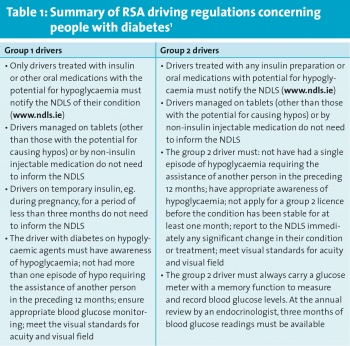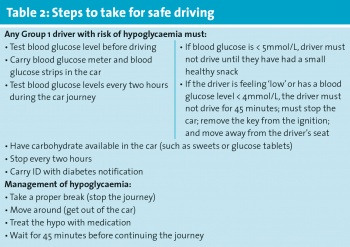DIABETES
Staying safe behind the wheel
Diabetes Ireland is actively highlighting the fitness to drive guidelines and how they may impact on people with diabetes
July 1, 2015
-
With diabetes prevalence on the increase, it naturally follows that there will be more people with diabetes driving. This is why it is necessary for healthcare professionals and patients alike to be aware of how the condition may impact on the ability to drive safely and what driving regulations say. Anna Clarke, Diabetes Ireland health promotion and research manager, addressed this topic at the recent multidisciplinary diabetes study day held in Croke Park, Dublin.
“Internationally it is now accepted that there are many medical conditions that will affect the ability to drive, and this is why there are now regulations in place to deal with this,” said Ms Clarke.
The driving licence regulations changed in 2014, with the result that when a person now goes to renew their licence, the driver has to present themselves for a photograph that will be put on the new card and this can be used as an ID. Each driving licence has a unique code in itself, and medical conditions are also listed in code-format on the licence.
“So if you for example need to wear glasses while driving, this will be visible on the driver’s licence in the format of a specific code,’ explained Ms Clarke.
“There will also be codes for different medical conditions, so we need to include driving guidelines for people with diabetes at each consultation, especially if they are at risk of hypoglycaemia,” added Ms Clarke.
She highlighted that there is proof that if you are hypoglycaemic, you are more likely to have an accident. While there is no proof to say that if you have type 2 diabetes you are more likely to have an accident; there is proof that if you have type 1 diabetes you are more likely to have an accident, and as Ms Clarke pointed out, this is associated with the driver not properly following the correct practice regarding driving with diabetes.
“This is why we are now trying to reinstate what the correct practice is and make sure people are adhering to it,” said Ms Clarke.
“Thankfully, the number of accidents that have happened are not statistically significant enough to increase the risk of a payout and have therefore not affected motor insurance for people with diabetes yet,” she added.
Personal and professional responsibility
Any driver with diabetes, who is at risk of hypoglycaemia, needs to notify the National Driver Licence Service (NDLS). However, if a driver is on glucophage or other non-insulin injectables, there is no issue unless that driver suffers from other relevant complications, such as diabetic eye disease, etc.
“So there is no specific regulations for drivers with diabetes who are not on any medications for hypoglycaemia,” explained Ms Clarke.
The 2014 RSA guidelines1 have a specific section on drivers with endocrine conditions. They will tell healthcare professionals what needs to be checked to ensure that people are safe on the road.
“If you are asked to fill out a form to say that a person is medically fit to drive – and any individual that you are looking after who is at risk of hypoglycaemia will have to get this form completed – then you will have to look at visual acuity, cardiovascular status, and the patient’s diabetes medication,” said Ms Clarke.
Medical issues and special considerations
There are two categories of drivers’s licences, group 1 and group 2. Group 1 licences are for ‘personal’ driving, or meaning not driving in a commercial/vocational capacity. Anyone who holds a group 1 licence can drive vehicles, or vehicle combinations (eg. car and trailer) up to a total weight of 3,500kg and carry up to seven people in total, while drivers with a group 2 licence can drive vehicles above 3,500kg (buses, lorries, etc) and also take more than seven people.
The medical fitness to drive guidelines are very strict for group 2 licences and a driver needs specialist medical fitness to drive certification annually!
However, for the general driver with diabetes, some simple steps will fulfil the medical criteria laid out in the fitness to drive guidelines.
“Every driver who is at risk of hypoglycaemia must test their blood glucose before they get in to their car, and keep a record of that test,” explained Ms Clarke.
“They must also test their glucose every two hours while they are driving, and this could be done while they stop and stretch their legs, which is good practice anyway.
“If a driver’s blood glucose is less than 5 they do not drive, they have to correct their hypoglycaemia. If their blood glucose is less than 4, they should not drive for 45 minutes.
“For group 1 drivers, the licence is issued for one year or three years, but not for 10 years if they have to fill out the medical form.”
All those with diabetes, also have to inform their insurance company about their condition.
 (click to enlarge)
(click to enlarge)

 (click to enlarge)
(click to enlarge)